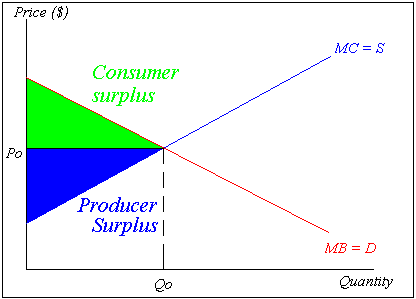Allocative efficiency in a perfectly competitive market.
Introduction to microeconomics. | home
Chat room!
Allocative efficiency in a perfectly competitive market.
Allocative efficiency: A condition achieved when resources are allocated in a way that allows the maximum possible NET BENEFIT from their use. When an efficient allocation of the resources has been attained, it is impossible to increase the well-being of anyone person without harming another person.Consumer surplus: Is the total net benefit that all consumers purchasing the good enjoy. For consumers in the aggregate, it is the area between the demsnd curve and the market price.
Producer surplus: is the difference between the market price the producer receives and the marginal cost of producing this unit. It represents the profit on the unit, plus any rents accruing to factors of production. For a market as a whole, producer surplus is the area above the supply curve up to the market price.

Illustration of consumer surplus.

Consumer A would pay $10 for a good whose market price is $5. And therefore enjoys the benefit of $5 ($10 - $5 = $5)
Consumer B enjoys a benefit of $2 ($7 - $5).
No benefit for consumer C, who values good at a market price.
Therefore Consumer surplus measures the total benefit to all consumers is shaded area between the demand curve & the market price.
Send your comments and suggestions: Cooldosh@mail.ru
Introduction to microeconomics.
Back to the top
